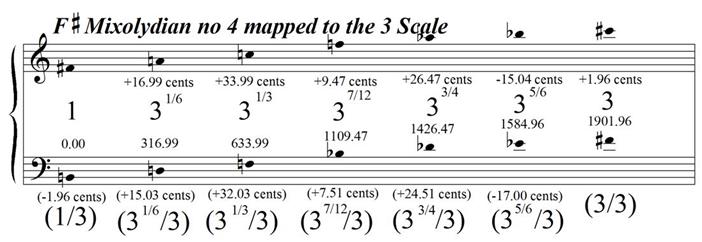
The F Sharp Mixolydian no 4 mapped to the Triative Scale. With the expansion of all the scalar intervals to fill in the 3/1 triative the gap left by the subtracted fourth degree opens up into a 475.48-cent leap between adjacent scale members.
 Jamie Branch/Marc Riordan Duo + Petter O Hanna @ The Red Room, Baltimore, MD
Jamie Branch/Marc Riordan Duo + Petter O Hanna @ The Red Room, Baltimore, MD Shonen Knife: Brand New Knife. 1997. MCA/Victor/Big Deal: 9035-2.
Shonen Knife: Brand New Knife. 1997. MCA/Victor/Big Deal: 9035-2. Brian Sacawa: American Voices. 2007. Innova: 675.
Brian Sacawa: American Voices. 2007. Innova: 675. Peggy Lee Band: Worlds Apart. 2004. Spool: SPL124.
Peggy Lee Band: Worlds Apart. 2004. Spool: SPL124.
 Don Byron: Do the Boomerang: The Music of Junior Walker. 2006. Blue Note Records: 0946 3 41094 2 0.
Don Byron: Do the Boomerang: The Music of Junior Walker. 2006. Blue Note Records: 0946 3 41094 2 0. Available Jelly: Monuments. 1993. Ramboy: 07.
Available Jelly: Monuments. 1993. Ramboy: 07. Wally Shoup/Toshi Makihara/Brent Arnold: Confluxus. 2004. Leo Records: 399.
Wally Shoup/Toshi Makihara/Brent Arnold: Confluxus. 2004. Leo Records: 399. Ludwig van Beethoven: The Complete Quartets - Volume I. Recorded in 1989. Delos: CD 3031.
Ludwig van Beethoven: The Complete Quartets - Volume I. Recorded in 1989. Delos: CD 3031. Aaron Dugan: {ten improvisations}. 2006. Jungulous: 001.
Aaron Dugan: {ten improvisations}. 2006. Jungulous: 001. Ornette Coleman Trio: At The "Golden Circle," Stockholm - volume one. 1965 (Rudy Van Gelder Edition released in 2002). Blue Note Records: 7243 5 35518 2 7.
Ornette Coleman Trio: At The "Golden Circle," Stockholm - volume one. 1965 (Rudy Van Gelder Edition released in 2002). Blue Note Records: 7243 5 35518 2 7.
 Anthony Braxton: Piano Quartet, Yoshi's 1994 [disc 4]. 1996. Music & Arts: CD 849.
Anthony Braxton: Piano Quartet, Yoshi's 1994 [disc 4]. 1996. Music & Arts: CD 849. Anthony Braxton 12+1tet: 9 Compositions (Iridium) 2006 - disc 3. Firehouse 12 Records: FH12-04-03-001.
Anthony Braxton 12+1tet: 9 Compositions (Iridium) 2006 - disc 3. Firehouse 12 Records: FH12-04-03-001. Ludwig van Beethoven: The Symphonies [disc 2 - Symphony No. 3 in E Flat major (op. 55) "Eroica"]. Recorded in 1994. The International Music Company: 205297-305.
Ludwig van Beethoven: The Symphonies [disc 2 - Symphony No. 3 in E Flat major (op. 55) "Eroica"]. Recorded in 1994. The International Music Company: 205297-305. After Now: Nothing you've heard before @ The Red Room, Baltimore, MD
After Now: Nothing you've heard before @ The Red Room, Baltimore, MD Have a Harmolodic Day!
Have a Harmolodic Day! Billy Higgins clearly had it. And one can hear it in his Skies of America, in Song X, in Dancing in Your Head, Three Women and clear into the more recent Sound Grammar. When James "Blood" Ulmer adapted harmolodic theory into his own playing one can hear that same sense of intervallic construction and disciplined freedom. Ornette Coleman's proximity to truth makes it difficult for him to convey what he knows with mere words. But his music is clear and speaks brilliantly to those who listen and experience it.
Billy Higgins clearly had it. And one can hear it in his Skies of America, in Song X, in Dancing in Your Head, Three Women and clear into the more recent Sound Grammar. When James "Blood" Ulmer adapted harmolodic theory into his own playing one can hear that same sense of intervallic construction and disciplined freedom. Ornette Coleman's proximity to truth makes it difficult for him to convey what he knows with mere words. But his music is clear and speaks brilliantly to those who listen and experience it.
